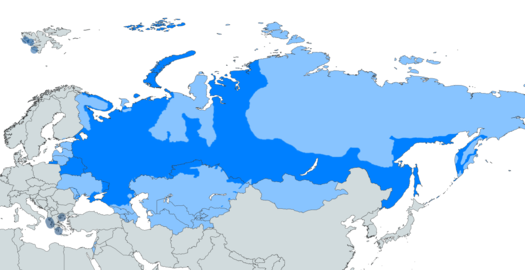Russian language facts
 Russian is a majority language
Russian is a majority language
Russian is a minority language
Russian is a spoken language
Spoken by the tsars and by renowned artists like Dostoevsky, Tolstoy, Pasternak and Prokofiev, Russian is the native language of some 160 million citizens of the Russian Federal Republic. It is one of the six official languages of the UN and ranks with English, Chinese and Spanish as a major world language.
What is more, Russian remains the unofficial lingua franca of the former Soviet republics, an indispensable communications tool across all of the Caucasus and Central Asia. Russian accounts for one-quarter of scientific publications, and it is an increasingly important language for business and trade as Russian institutions, both public and private, integrate with their European and American counterparts.

Although Russian as a modern cultural language is relatively new, with the vast majority of classic work having been produced in the 19th and 20th centuries, the wealth of the Russian cultural heritage in literature, visual art, theatre, opera, instrumental music, and ballet is enormous. Similarly, Russian language services have been frequently sought after in order to translate and interpret this language in different countries.
Roots of the Russian language
The sixth century AD saw the migration of the Slav people from old Poland. The Slavs expanded westwards to the river Elbe and southwards to the Adriatic sea where they gradually occupied much of the Balkans.
By the 10th century, three Slavonic language groups had emerged: Western, Southern and Eastern. Eastern Slavonic gave rise to the modern languages known as Ukrainian, Belorussian and Russian. The Slavonic languages retained many features in common especially in grammatical structure; therefore, the separate groups were able to use one common written language. This language was known as Old Slavonic or Old Church Slavonic (the language was used in its written form only). In the 9th century, two missionaries – Constantine (who on his deathbed took the monastic name Cyril) and Methodius – were required to write down the scriptures in Old Church Slavonic and to preach Christianity to the people of Moravia.
Before they set out for Moravia, Constantine invented a Slavonic, now known as Cyrillic, alphabet. The Cyrillic alphabet is closely based on the Greek alphabet, with about a dozen additional letters invented to represent Slavic sounds not found in Greek.
In Russia, Cyrillic was first written in the early Middle-Ages in clear-cut, legible ustav (large letters). Later a succession of cursive forms developed. In the early eighteenth century, under Peter the Great, the forms of letters were simplified and standardised, with some appropriate only to Greek being removed. Further unnecessary letters were expunged in 1918, leaving the alphabet as it is today.